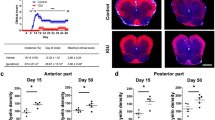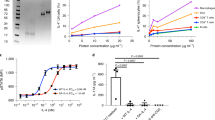Abstract
The accepted model for the human demyelinating disease, multiple sclerosis (MS), is experimental allergic encephalomyelitis (EAE). We assessed the ability of SC-41930(7-[3(4-acetyl-3-methoxy-2-propylphenoxy)-propoxy]-3,4-dihydro-8-propyl-2H-1-benzopyran-2-carboxyl acid), to modulate the symptoms of acute EAE generated in guinea pigs. Animals were pretreated with SC-41930 (20 mg/kg, i.p.) for two days followed by thrice-weekly maintenance. At day 52, a significant number of the SC-41930-treated animals were alive as compared to EAE alone. Control animals had an increase in body weight while EAE animals lost over 20% (p<0.5) of their body weight by day 18. SC-41930-treatment significantly reduced, but did not completely inhibit the cachectic response. The results indirectly implicate LTB4 in the pathogenesis of EAE. Agents that modify this model be useful in the treatment of human MS.
Similar content being viewed by others
References
S. Levine,Hyperacute, neutrophilic and localized forms of experimental allergic encephalomyelitis. Acta Neuropath. (Berl.)28, 179–189 (1974).
R. L. Shone, S. W. Djuric, B. S. Tsai, D. J. Fretland, T. S. Gaginella and C. S. Cook,SC-41930. Drugs of the Future15, 695–697 (1990).
M. J. DiMartino, C. E. Wolff, G. K. Campbell and N. Hanna,Inhibition of experimental allergic encephalomyelitis by a new antiinflammatory compound, SKF86002. Ann. N.Y. Acad. Sci.540, 578–580 (1988).
S. Desai and R. Barton,Pharmacological comparison of active and passive experimental allergic encephalomyelitis in rats. Agents Actions27, 351–355 (1989).
D. W. Howat, N. Chand, P. Braquet and D. A. Willoughby,An investigation into the possible involvement of platelet activating factor in experimental allergic encephalomyelitis in rats. Agents Actions27, 473–476 (1989).
M. Prosiegel, I. Neu, J. Mallinger, A. Wildfeuer, L. Mehlber, S. Vogl, G. Hoffmann and G. Ruhenstroth-Bauer,Suppression of experimental allergic encephalomyelitis by dual cyclooxygenase and 5-lipoxygenase inhibitor. Acta Neurol Scand79, 223–226 (1989).
M. Prosiegel, I. Neu, S. Vogl, G. Hoffmann, G. Wildfeuer and G. Ruhenstroth-Bauer,Suppression of experimental allergic encephalomyelitis by sulfasalazine. Acta Neurol. Scand.81, 237–238 (1990).
R. Lewis and H. Granger,Diapedesis and permeability of venous microvessels to protein macromolecules: the impact of leukotriene B 4. Microvascular Res.35, 27–47 (1988).
Author information
Authors and Affiliations
Rights and permissions
About this article
Cite this article
Fretland, D.J., Widomski, D.L., Shone, R.L. et al. Effect of the leukotriene B4 receptor antagonist, SC-41930, on experimental allergic encephalomyelitis (EAE) in the guinea pig. Agents and Actions 34, 172–174 (1991). https://doi.org/10.1007/BF01993269
Issue Date:
DOI: https://doi.org/10.1007/BF01993269




